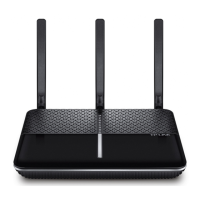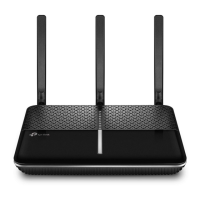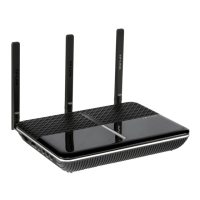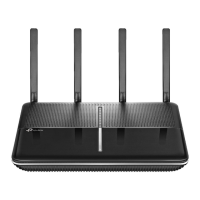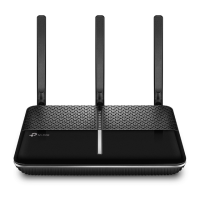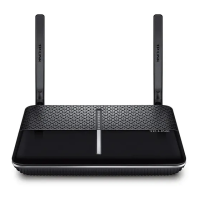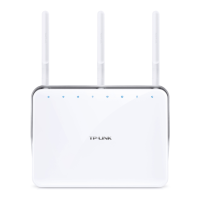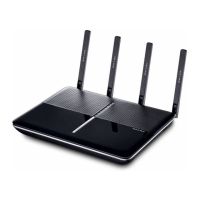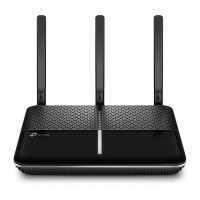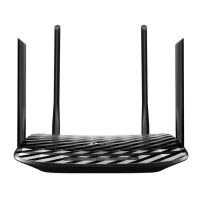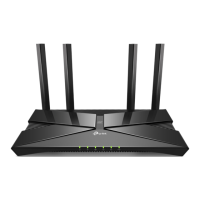Do you have a question about the TP-Link Archer VR400 V2 and is the answer not in the manual?
Overview of the modem router's features and benefits.
Details on the physical layout and components of the modem router.
Guidance on optimal placement of the modem router for best performance.
Step-by-step instructions for physically connecting the modem router.
Guided setup process for establishing an internet connection quickly.
Steps for configuring internet connection settings manually.
How to verify the internet connection is working correctly after setup.
Configuration for setting up an internet connection using IPv6.
Details on alternative operating modes for the modem router.
Control network access based on device MAC addresses.
Block or allow specific devices from accessing the network.
Prevent ARP spoofing by binding IP addresses to MAC addresses.
Share USB storage devices connected to the router on the network.
Access USB disk contents remotely using an FTP server.
Stream media files from USB storage to DLNA-supported devices.
Share a connected USB printer with multiple computers.
Configure the router to use a 3G/4G USB modem for internet access.
Set up a separate Wi-Fi network for guests.
Configure bandwidth and access permissions for guest networks.
Expose local services on the internet using virtual servers.
Dynamically open ports for specific applications like games.
Place a device in the DMZ to bypass port restrictions.
Enable UPnP for seamless online gaming and application communication.
Configure local area network settings like IP addresses and DHCP.
Configure LAN settings for IPv6 addressing.
Customize wireless network parameters such as SSID, password, and security.
Configure Dynamic DNS for remote access using a domain name.
Group network interfaces to control inter-group communication.
Define static routes for specific network traffic paths.
Establish a VPN tunnel for secure remote access.
Configure tunnels to access IPv6 resources over an IPv4 network.
Configure the modem router's system time for accurate logging and scheduling.
Instructions for updating the router's firmware to the latest version.
Save and load router configurations for backup or recovery.
Modify the login username and password for router management.
Control which local devices can manage the modem router.
Enable and configure remote access to manage the modem router.
View system logs to diagnose issues and troubleshoot problems.
Track internet traffic volume and packet statistics.
Configure CWMP (TR-069) for remote device management.
Configure SNMP settings for network management and monitoring.
Overview of the modem router's features and benefits.
Details on the physical layout and components of the modem router.
Guidance on optimal placement of the modem router for best performance.
Step-by-step instructions for physically connecting the modem router.
Guided setup process for establishing an internet connection quickly.
Steps for configuring internet connection settings manually.
How to verify the internet connection is working correctly after setup.
Configuration for setting up an internet connection using IPv6.
Details on alternative operating modes for the modem router.
Control network access based on device MAC addresses.
Block or allow specific devices from accessing the network.
Prevent ARP spoofing by binding IP addresses to MAC addresses.
Share USB storage devices connected to the router on the network.
Access USB disk contents remotely using an FTP server.
Stream media files from USB storage to DLNA-supported devices.
Share a connected USB printer with multiple computers.
Configure the router to use a 3G/4G USB modem for internet access.
Set up a separate Wi-Fi network for guests.
Configure bandwidth and access permissions for guest networks.
Expose local services on the internet using virtual servers.
Dynamically open ports for specific applications like games.
Place a device in the DMZ to bypass port restrictions.
Enable UPnP for seamless online gaming and application communication.
Configure local area network settings like IP addresses and DHCP.
Configure LAN settings for IPv6 addressing.
Customize wireless network parameters such as SSID, password, and security.
Configure Dynamic DNS for remote access using a domain name.
Group network interfaces to control inter-group communication.
Define static routes for specific network traffic paths.
Establish a VPN tunnel for secure remote access.
Configure tunnels to access IPv6 resources over an IPv4 network.
Configure the modem router's system time for accurate logging and scheduling.
Instructions for updating the router's firmware to the latest version.
Save and load router configurations for backup or recovery.
Modify the login username and password for router management.
Control which local devices can manage the modem router.
Enable and configure remote access to manage the modem router.
View system logs to diagnose issues and troubleshoot problems.
Track internet traffic volume and packet statistics.
Configure CWMP (TR-069) for remote device management.
Configure SNMP settings for network management and monitoring.
| Wi-Fi Standard | 802.11ac |
|---|---|
| Frequency Band | 2.4GHz and 5GHz |
| USB Port | 1 x USB 2.0 |
| Antenna Type | External |
| Antenna Quantity | 3 |
| Beamforming | Yes |
| Guest Network | Yes |
| Wireless Security | WPA/WPA2, WPA-PSK/WPA2-PSK |
| Wi-Fi Speed | 1200 Mbps |
| DSL Compatibility | VDSL/ADSL |
| Security Features | Firewall, Parental Controls, Access Control |
| Device Type | Modem Router |

